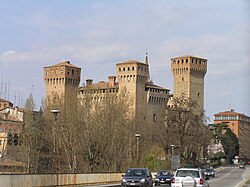| Vignola | ||
 | ||
| State | Italy | |
|---|---|---|
| Region | Emilia Romagna | |
| Territory | Modenese | |
| Altitude | 125 m a.s.l. | |
| Surface | 22.86 km² | |
| Inhabitants | 25.622 (2019 | |
| Name inhabitants | Vignolesi | |
| Prefix tel | 39 059 | |
| POSTAL CODE | 41058 | |
| Time zone | UTC 1 | |
| Patron | Saints Nazario and Celso (13 October) | |
Position
| ||
| Institutional website | ||
Vignola is a city ofEmilia Romagna.
To know
The Vignola denomination, which derives from the Latin vineola, a small vineyard, indicates the cultivation of the vine, widely practiced in Roman times on the alluvial soils of the Panaro. Even today, even if the local economic fabric is made up of small and medium-sized enterprises ranging in different economic sectors, the agricultural vocation is deeply rooted in the territory, so much so that Vignola is known throughout Europe for its cherry production. First of all the cherry note Mora di Vignola.
Geographical notes
It is located a short distance from Modena, in view of the first Apennine hills.
How to orient yourself
Its municipal territory also includes the localities of Bettolino, Campiglio, Pratomaggiore and Tavernelle-
How to get
By plane
- 1 Bologna airport, Via Triumvirato 84, ☎ 39 051 6479615.
- 2 Parma airport (G. Verdi), Via Emilia - Golese locality, ☎ 39 0521 951511.
- 3 Verona Airport (Catullus), Boxes of Sommacampagna, ☎ 39 045 8095666, @[email protected].
By bus
- SETA bus lines [1] (Società Emiliana Trasporti Autofiloviari): It is the main company that manages public transport in Modena and its province.
How to get around
What see
- 1 Rocca.
- Parish Church of Saints Nazario and Celso. It is mentioned for the first time in a document dated 1299. Rebuilt in the 15th century, it was rebuilt again starting from 1680 on a design by Zaccaria Pellini. There are preserved a bronze Pietà from the twentieth century, the work of Ivo Soli, seventeenth-century paintings by Elisabetta Sirani (Madonna between Saints Anthony and Francis), Simone Cantarini (St. John the Evangelist), Francesco Stringa (Madonna and saints), a Adoration of the Magi from the Bolognese school, and a Martyrdom of Saints Nazario and Celso by the nineteenth-century painter Adeodato Malatesta-
- Sanctuary of the Madonna della Pieve. The Romanesque building is mentioned for the first time in a document dated 1174. Having fallen into ruins, it was rebuilt in 1615 and only the apse part of the original Romanesque remains. There is a medieval statue depicting the Madonna enthroned with Child and some stone wall fragments with reliefs that attest to the existence of a religious settlement even prior to the Romanesque era. Near the sanctuary there is a bronze statue of the Holy Family, the work of the local sculptor Marco Fornaciari.
- Contrari-Boncompagni Palace (Barozzi Palace). It was built around the middle of the 16th century for Ercole Contrari by the Ferrara architect Bartolomeo Tristano but based on a design by Jacopo Barozzi. Inside there is an oval-shaped staircase also by Bartolomeo Tristano. Passed to the Boncompagni, in 1880 the prince Antonio Boncompagni Ludovisi had frescoes painted by the Modenese painters Fermo Forti and Angelo Forghieri.
- Church of Santa Maria in Tortiliano (Santa Maria Rotonda) (2 km from Vignola on the road to Maranello). Small church with a circular plan, it was rebuilt in 1491 by Bartolomeo Moreni on a precedent which we have news of from the eighth century. Characteristic for the particular structure formed by two overlapping cylinders with a hemispherical dome, it preserves a sixteenth-century fresco depicting the Madonna enthroned with the Child and the founder Bartolomeo Moreni, with a view of Vignola in the background

